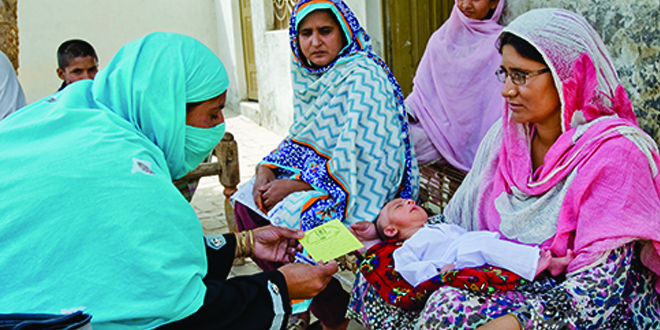
Lady Health Workers dilemma in Pakistan
The National Program for Family Planning and Lady Health Workers (LHW) Program was launched in 1994. The objectives were to reduce poverty through providing essential PHC services and improving maternal, newborn and child health and provide family planning (FP) services.
The catchment area of each LHW includes approximately a population of 1000 persons or 150 homes. They are responsible to counsel on various health issues, provide FP services, do antenatal Care referrals, provide immunization services and basic curative care, and support community mobilization.
Since independence, Pakistan has faced persistent political instability; and, it has adversely affected Pakistani society in terms of foreign affairs, finance, education, health care and social services. Organizational support related to FP services is present; such as, Green Star, a non-profit, Non-Governmental Organization (NGO) working through the private sector and with the government to improve the quality of life by allowing healthier choices, and improving access to affordable, high quality reproductive health products and services.
When the 18th Amendment was passed by the parliament, it resulted in dissolving the Ministry of Population Welfare (MoPW) and Ministry of Health (MoH). This led to major financing issues related to the program, because of poor planning and management.
In Pakistan, social, cultural and ethical values influence health decisions. Men are more privileged in taking decisions for self and their families; whereas women are less valued and they are expected to obey their family decisions. Such profound inequalities bound women’s ability to plan their pregnancies; and, so does lack of access to useful RH care services including FP.
Hence, LHWs are the ones who can facilitate social change that favor women’s empowerment. Moreover, there is a need of male social mobilizers and workers who can strengthen linkages with LHWs to increase accessibility of the FP services.
Standardized tools such as ‘Health Workers for Change’ for working with health providers and ‘Initiating Women Empowerment for Health’ can be useful to interact with the community. Both tools focus on women’s health and social issues affecting their health status.
This approach endeavors to sensitize the health service providers to the health needs of female clients and encourages behavioral changes.
According to the Pakistan Demographic Health Survey (PDHS, 2012-13) report, the total fertility rate (TFR) in Pakistan is 3.8; and the urban areas equals to 3.2 and the rural areas equals to 4.2. The contraceptive prevalence rate (CPR) is 35%. Stagnation in contraceptive use reflects the unmet needs.
Only around 12% of all married women of reproductive age, 2.9 million women, access any FP service in Pakistan; and, the public sector reaches approximately 4% of all married women of reproductive age. Demand for FP refers to the desire of couples to control their future fertility.
There is a demand for FP services when the number of children exceeds the desired level of fertility, or when spacing between births is preferred. Poor accessibility and quality of FP services lead to reduced health status and customer satisfaction, and increased financial risk.
Since the past years, it is seen that LHWs extensive involvement in polio campaigns, tuberculosis treatment initiatives, and the national census have contributed towards the dilution of LHWs support towards family planning services. Hence, 50% of FP services are self-procurement of condoms and pills by women directly without any contact with a health provider.
LHWs have a contractual nature of job and have low salary scale, and at times they are not paid regularly. Moreover, there is no further career development for the LHWs; because of low qualification and lack of continuing education sessions. Hence, this leads to less efficiency from the LHWs as a result the output of their work is also decreased.
A specific amount of budget is allocated by the government to finance different vertical health programs, including the LHWs program, but, the rest of the health expenditure will have to come from the provinces. As provinces are now responsible for financing the programs, funding is decreasing, and the gap between the need and the available resources is growing.
To overcome the above stated issues, a client-centered approach should be present. Political support can be important in terms of fund raising for FP services. Resources should be allocated appropriately to fulfill community requirements. Stipend should be paid to the LHWs to keep them motivated and retained. There should be a well-established supportive supervisory network from the community to the federal level, to monitor the program.
Further expansion and strengthening of LHWs program and making it an integral part of PHC services can be a good start. Giving LHWs permanent government employee status and a raise in salary may strengthen their role. Community-based distribution campaigns and social marketing efforts should be held to increase the accessibility of birth-spacing methods. LHWs should be trained and refresher trainings should be conducted to update their knowledge and skills.
Stakeholder’s commitment in terms of social and economic policies should be secured to minimize inequity. For provision and accessibility of FP services there is a need for an integrated approach by the government policymakers and program planners, donors, technical organizations, facility-based family planning service providers, managers, community-based health workers, community leaders, and professional associations of family planning service providers.
About the author: Shahnaz Shahid has done MScN, RN, RM and is currently a faculty member at the Aga Khan University School of Nursing and Midwifery. She is interested in midwifery education, research and practices with her major work focus relating to maternal, neonatal, child and reproductive Pakistan health
News source: AFP

